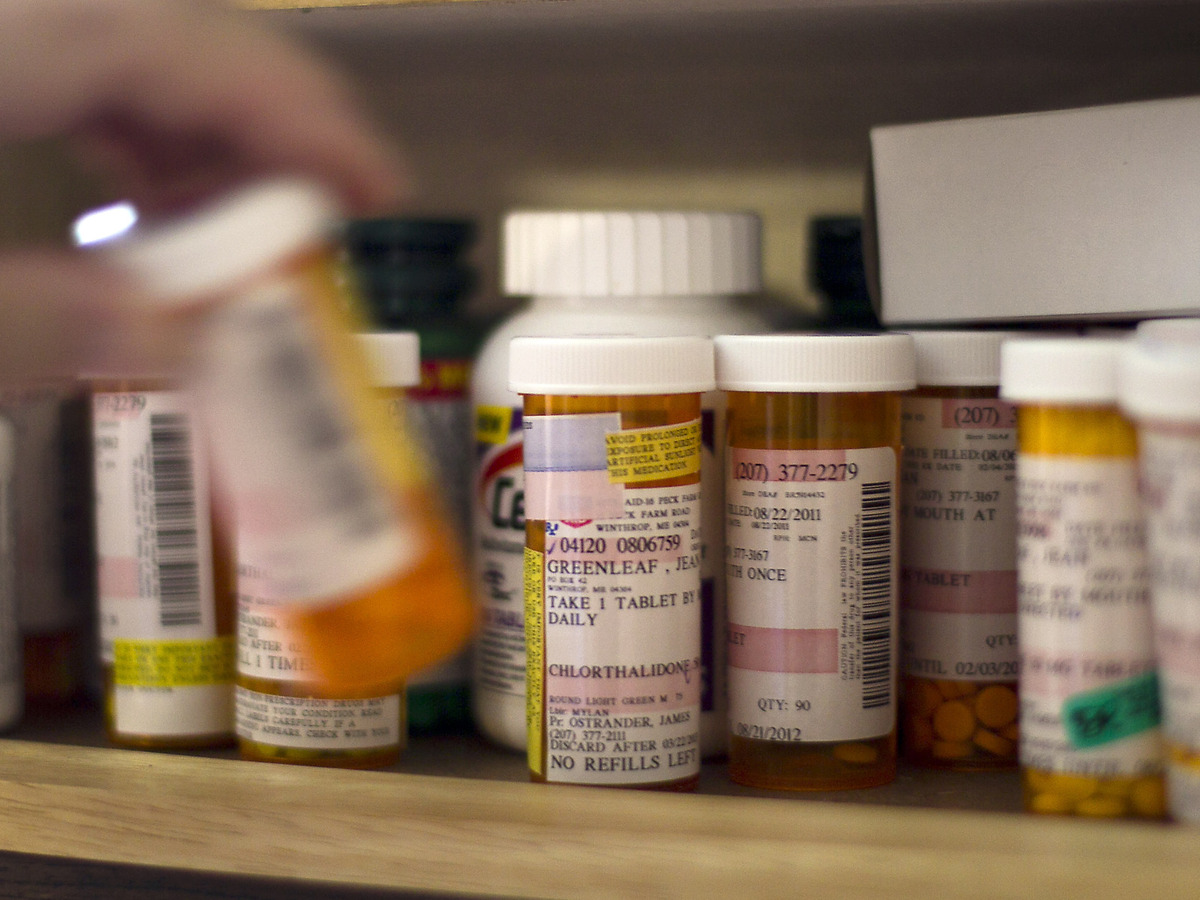
Pharmacy benefit managers are intermediaries who work with drug companies and insurers, helping set retail prices for the prescription drugs Americans rely on for their health. They are now the subject of a series of new bills in Congress.
Robert F. Bukaty/AP
hide caption
toggle caption on/off
Robert F. Bukaty/AP

Pharmacy benefit managers are intermediaries who work with drug companies and insurers, helping set retail prices for the prescription drugs Americans rely on for their health. They are now the subject of a series of new bills in Congress.
Robert F. Bukaty/AP
Ominous announcements about prescription drugs have flooded the airwaves and television in recent months. Perhaps by design, it’s not always clear who sponsors the ads or why.
Or, for that matter, why now?
The short answer is that Congress is paying attention. House and Senate members from both parties have launched at least nine bills, parts of which could be packaged together this fall, that target pharmacy benefit managers, companies that funnel prescription drugs to patients. Here’s a primer to help you decipher what’s going on.
What are pharmacy benefit managers?
Known as PBMs, these companies were created in the 1960s to help employers and insurers select and purchase drugs for their health plans. The industry has grown rapidly as spending on prescription drugs has grown nearly 200-fold between 1967 and 2021. In addition to negotiating rebates with manufacturers, PBMs set payment terms for pharmacies that purchase and distribute prescription drugs. medications to patients. Indeed, they are the dominant intermediaries between drug manufacturers, pharmacies, insurers, employers and patients.

How big is the PBM industry?
There are approximately 70 PBMs in the U.S. Through mergers, three of which CVS Caremark, Optum Rx, and Express Scripts have come to control 80 percent of the prescription drug market, and each generate tens of billions of dollars in revenue annually. PBMs control the pipeline of drugs from manufacturers to the pharmacy counter.
Their purchasing power allows them to obtain discounted drugs for health plans, setting prices and conditions for sales in pharmacies. The big three are part of huge conglomerates with major stakes in nearly every sector of health care; each of them owns powerful health insurer Aetna, UnitedHealth and Cigna respectively, as well as pharmacies and medical providers.
For example, UnitedHealth contracts 70,000 physicians, making it the largest employer of physicians in the country. CVS Health, with the large pharmacy chain, also owns Caremark and Aetna. The secret price negotiations and hidden corners of every PBM-connected company make it difficult to keep track of where the money goes.
Why am I seeing all these ads about PBMs?
Other sectors of health care are alarmed by the power of the PBMs and are calling on the Biden administration and Congress to bring them under control. chafe over PBM practices such as “spread pricing,” in which companies pocket negotiated money on behalf of health plans.
Non-PBM-affiliated pharmacists, from mom-and-pop stores to big chains like Kroger, say PBMs restrict their activities by forcing them to sign opaque contracts that include paybacks long after sales have taken place. PBMs often refer patients using expensive drugs to their affiliated pharmacies, cutting revenue for independents.
Doctors say PBMs act as gatekeepers for the insurers they represent, blocking or slowing coverage of needed drugs.
Finally, the pharmaceutical industry has lost a share of sales revenues to PBM intermediaries in recent years, despite receiving most of the bad press for high drug prices. (The average introductory price for newly marketed brand-name drugs rose from $2,100 to $180,000 annually between 2008 and 2021, but net revenues for drug companies have stagnated in recent years.)
PBMs in some cases prefer high manufacturer’s list prices, because the rebates drug makers pay PBMs in exchange for favorable health coverage of their drugs are often calculated as a percentage of those list prices.
Who pays for ads?
Pharmaceutical Research and Manufacturers of America, the trade group of most of the large pharmaceutical companies, is the main driver of the anti-PBM campaign. Some of the ads are sponsored by the PBM Accountability Project, a pop-up lobby, funded in part by the pharmaceutical industry, that includes unions and patient advocates whose members complain about the restrictive policies of the PBM and the insurance industry.
In a PhRMA commercial, a slimy guy in a suit steals a young woman’s prescription. The Pharmaceutical Care Management Association trade group PBM responded with its own ads, blaming drug companies for high prices and for “targeting your pharmacy perks.” AHIP, the health insurance lobby, has continued its campaign.
What is Congress doing about it?
Members of both parties speak indignantly of the PBM’s behavior and have launched bills to address it. The Senate Finance Committee, whose jurisdiction over Medicare and Medicaid gives it a prominent role, introduced a bill that would ban PBMs from collecting rebates and fees calculated as a percentage of a drug’s list price, to discourage PBM from favoring expensive drugs.
The committee also plans legislation to require PBMs to pass discounts directly to seniors, allow patients to use the pharmacy of their choice, and release more information about where their money goes.
Sen. Bernie Sanders, who leads the Senate Committee on Health, Education, Labor and Pensions, has introduced a bill banning spread pricing, while measures in the Senate and House would crack down on PBM practices seen as harmful to independent and rural pharmacies. Other measures require greater transparency or limit patient waits for drug approvals.
Meanwhile, several states have taken a pragmatic path to reduce PBM-related costs, using high-tech auctions to get the best deals on their employee health care plans.
What’s the bottom line?
While PBMs’ secrecy, ubiquity, and power make them a target of outrage, they generally operate on behalf of their clients, which are insurance plans and employers, whose goal is to keep prices down. PBMs do this by extracting painful concessions, a double-edged sword.
“PBMs are the only thing we have to drive down the prices of brand-name drugs and keep the pharmaceutical industry from charging for what they want,” said Benjamin Rome, an internist and health policy researcher at Harvard Medical School.
If those drug prices were 100% covered by insurance, that might be fine for consumers, but it would further blow up health care spending, already nearly a fifth of the economy. Hospitals, insurers, the pharmaceutical industry and PBMs all point fingers at each other to shift blame, but they all benefit from the system. The PBM slimy guy in the suit might keep you from getting the drug your doctor ordered, but that’s only because the manufacturer of another drug gave him and therefore your insurance company got a better deal.
On the other hand, the vertical integration of PBMs allows for unfair competition is an issue that the Federal Trade Commission is studying but which is not the subject of any bill in Congress. “My concern with any bills is the unintended consequences,” Rome said. “Will the new facilities they create be better for patients?”
KFF health newsformerly known as Kaiser Health News (KHN), is a national newsroom that produces in-depth journalism on health issues and is one of the leading operational programs of KFF extension the independent source for health policy research, polling and journalism.
#drug #price #fight #commercials
Image Source : www.npr.org